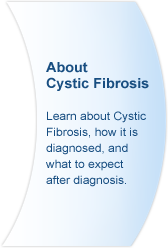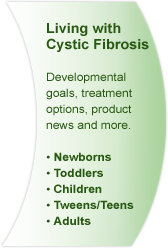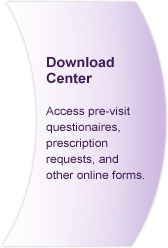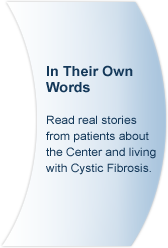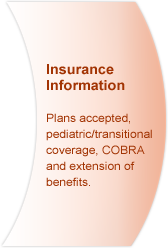|
|||||||
 |
 
Secondary Diseases
DID YOU KNOW?Healthy CF genes make a protein - CFTR (Cystic Fibrosis conductance Transmembrane Regulator) - found in cells that line organs like the lungs and pancreas. CFTR controls the movement of chloride, sodium and other electrically charged particles through the cells. The defect in the protein that causes Cystic Fibrosis thickens mucus secretions that affect the lungs and also blocks the flow of enzymes from the pancreas to the intestines. As a result, people with CF are susceptible to additional diseases, and will be treated by endocrinology, gynecology, orthopedic, gastroenterology, otolaryngology (ear-nose-throat), and urology specialists in addition to their internist/pediatrician and pulmonary/CF doctors.This section will help you understand some of the secondary diseases that may develop when you have CF. Did you know ...
Allergic Bronchopulmonary Aspergillosis (ABPA)Aspergillus species is a fungus that lives in the airways of adolescents and young adults with CF. Approximately 2-11% of people with CF develop an allergy to aspergillus called Allergic Bronchopulmonary Aspergillosis (ABPA). ABPA causes additional inflammation of the lungs, and if untreated can cause further scarring and fibrosis.Symptoms: Symptoms of ABPA are similar to CF, but your health often gets worse without a reason.
ABPA is more common in:
Treatment involves prevention and treatment of acute (flare up) episodes. Inflammation is treated with corticosteroids such as prednisolone, prednisone, or methylprednisolone, often for several weeks until the symptoms have gone away. Fungal colonization is treated with anti-fungal medicines such as Itraconazol to reduce long-term disease progressions. Each medication has side effects - your CF Care Team will discuss any potential side effects and how to handle them. Cystic Fibrosis-Related Diabetes (CFRD)Cystic fibrosis related diabetes (CFRD) is becoming an increasingly common complication of CF, characterized by an increase in blood sugar levels (hyperglycemia) and puts people with CF at risk of weight loss and reduced lung function.CFRD is caused by damage to the pancreas. The pancreas secretes enzymes needed for digestion; however, the thick secretions associated with CF prevent it from doing so. The lack of pancreatic secretions is the reason that over 90% of people with CF have to take enzymes with every meal. The main role of the pancreas is to release insulin into the bloodstream to control sugar levels. As people with CF get older, the pancreas sustains more damage and loses its ability to make and release insulin and diabetes develops. CFRD is a specific type of diabetes that has features of other, more common types of diabetes. There is a decrease in insulin secretion, just like type 1 diabetes, also known as juvenile-onset or insulin-dependent diabetes. CFRD is also characterized by a rise in sugar levels, primarily after a meal, similar to type 2 or non-insulin dependent diabetes. The probability of developing CFRD increases with age at a rate of about 10% per decade, For example, about 20% of people with CF between the ages of 20 and 30 have diabetes and the percentage rises to about 30% for those aged 30 to 40. In addition, a comparable percentage of people with CF have pre-diabetes or glucose intolerance. It is presently estimated that 30% to 40% of people with CF have glucose intolerance. Screening and Diagnosis The diagnosis is not difficult to make if a person has elevated blood sugars found on routine blood work. However, the recommendations are to catch the condition in early stages. The glucose tolerance test (OGTT) is the recommended method for screening and diagnosing. This test is usually administered once a year, starting in puberty. Two blood samples are taken, the first after fasting and the second two hours after the patient has drunk a beverage containing a set amount of sugar (typically 75 grams). Glucose levels after fasting and two hours after drinking the beverage indicate the body's ability to regulate sugar levels (glucose tolerance). Ideally, this test should be done when the person is without an active infection and not taking oral or IV antibiotics; if the results are abnormal, sometimes a second test is done to confirm the diagnosis. What does the treatment involve? CFRD is managed jointly by an endocrinologist (diabetes specialist), the CF doctor and a nutritionist. What dietary changes need to be made? It is very important to understand that the diagnosis of CFRD leads to dietary recommendations that differ from those suggested for other types of diabetes. Unlike in these other forms of diabetes, in the case of CFRD, sugar intake must never be reduced or eliminated. Emphasis should be placed on a generous diet (120-140% of theoretical needs), which is required to maintain or attain a satisfactory weight. However, it is useful to be aware of the various sources of sugars (carbohydrates) so as to be able to choose foods that the body digests more gradually (food that is high in fiber, such as whole-grain rather than white bread), and also to be able to divide them up among the various meals and snacks throughout the day. Quite often, these changes are enough to reduce glucose levels so that they do not pose any danger to the patient. Remember high sugars interfere with the immune system, making a person more susceptible to infections and causing weight loss because the body is not able to use the glucose for energy or to build bulk. Unfortunately, if sugar levels are very high, treatment with medications will be necessary. Although insulin is the only recommended treatment, pills can also be prescribed, especially early on when the pancreas is still making a little insulin. There are two main types of insulin:
At the beginning, insulin therapy requires a lot of training: injection techniques, nutrition, and how to recognize and treat hypoglycemia (low blood sugar). In addition, insulin is easily damaged by freezing and hot temperatures, so patients must know how to store and transport it. Sometimes learning can be overwhelming for those having a hard time accepting a treatment based on injections. The most commonly used injection is the insulin pen. It has a cartridge to which a tiny needle is attached. This device is small and can be kept at room temperature for one month; therefore it is very easy to carry around. In some cases, patients may use an insulin pump. Insulin can be injected into the abdomen, thighs, buttocks and upper arms. Because of the size of the needles, the injections are relatively painless. Oral agents (Pills) There are two main types of oral agents: those that increase insulin secretion and those that boost the action of insulin in tissues. Only the former have clearly demonstrated their ability to control glucose levels in CF. The most commonly used oral agent is glyburide (DiaBeta); however, it can cause hypoglycemia (low blood sugar). Occasionally other drugs like Metformin are used. For the majority of people with CF, these oral agents end up losing their effectiveness, and treatment will eventually require starting insulin. Source: Adult Cystic Fibrosis Committee of Quebec; SVB 35:2011 Distal Intestinal Obstruction Syndrome (DIOS)Distal intestinal obstruction syndrome (DIOS) is a type of constipation caused by a buildup of mucus that lines the intestinal walls. This buildup reduces the inner diameter of the intestines, making blockage more likely. You may also hear this condition referred to as meconium ileus equivalent.DIOS can be triggered by hot weather, decreased fluid intake and inadequate enzyme intake. Women who are pregnant or menstruating may also have episodes of DIOS or other types of constipation. DIOS can cause stomachaches, abdominal cramping (both can be unusually painful), constipation, a lower backache, or a feeling of fullness that is sometimes accompanied by diarrhea. In this instance, the diarrhea is a result of fluids seeping around the intestinal blockage. If the symptoms persist for more than 24 hours, call your CF physician for advice. To get rid of DIOS, you may be prescribed a laxative or enema. In some cases, treating the blockage may require hospitalization. After the obstruction has been cleared, a diet high in fiber and fluids is recommended. OsteoporosisAs a person living with CF, you are at risk for poor bone health, which increases your risk for osteoporosis, osteopenia and broken bones later in life. Getting enough calcium and vitamin D in your diet builds bone mass in children and teens and helps keep adult bones healthy. Zinc, magnesium, phosphorous, fluoride, proteins and vitamins K and A are also needed to build a keep strong bones. Weight-bearing exercise (walking, jogging, jumping rope, dancing, weight lifting, etc.) is also very important in building and keeping healthy bones. Your CF dietician or care provider can answer questions about preventing osteoporosis. Learn more about bone health here.Since people with CF have low bone minerals, they are prone to osteopenia, or low bone mineral density. In CF, it can happen at any age, but becomes more common in the later teen and adult years. Osteopenia or osteoporosis could cause fracturing of a chest bone, making deep breathing, airway clearance and even a lung transplant difficult. One cause of bone disease in people with CF is poor food digestion, or malabsorption, where the body may not get the vitamin D and calcium that are essential to bone health. The right amount of pancreatic enzymes and food are necessary for a good diet, good body weight and healthy bones. Low body weight can lead to low bone density and fractures. Lung infections cause inflammation. This can also lead to bone loss, so it is essential to treat infections early. Caffeine, alcohol, tobacco, certain medicines - including steroids, birth control, immunosuppressants, aluminum-containing antacids, certain herbal medications and "natural supplements" - can make you prone to bone disease. It's always a good idea to check with your CF care team as to whether medications or supplements affect bone health. To treat bone disease in CF, your care team may prescribe calcium and vitamin D supplements if levels are low. You may also take medications called bisphosphonates to strengthen bones. These should only be used in those patients with known fractures from weak bones or organ transplants. A life of good nutrition and exercise leads to healthy, strong bones. As people with CF age, bone health can raise the quality of life. To learn more, talk with your CF care team. Oxacillin Resistant Staph aureus (ORSA) and Methicillin Resistant Staph aureus (MRSA)What are ORSA and MRSA? Staph (Staphylococcus aureus) is a bacteria often found on the skin. Oxacillin and Methicillin are in the penicillin drug family, and some strains of Staph have become resistant to these and related medicines. ORSA and MRSA are different names for the same bacteria. ORSA and MRSA and Staph can be found anywhere on your skin, in your nose and in other moist locations. While ORSA/MRSA is generally not more serious than regular Staph, patients with a history of ORSA/MRSA should inform their health care providers to proper antibiotics can be prescribed.Who can get ORSA/MRSA? Anyone can carry ORSA/MRSA on their skin, and a break in the skin (bug bite, scratch) can increase the chance of infection. Some people notice a red or painful small bump or pimple under their skin. People with a greater chance of getting ORSA/MRSA include:
|
||||||
